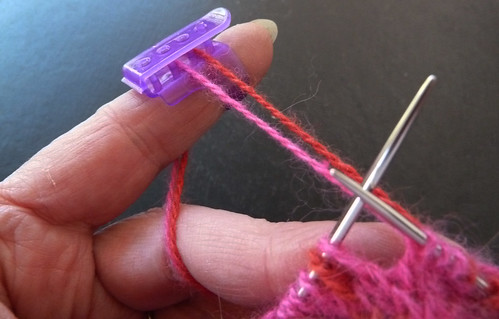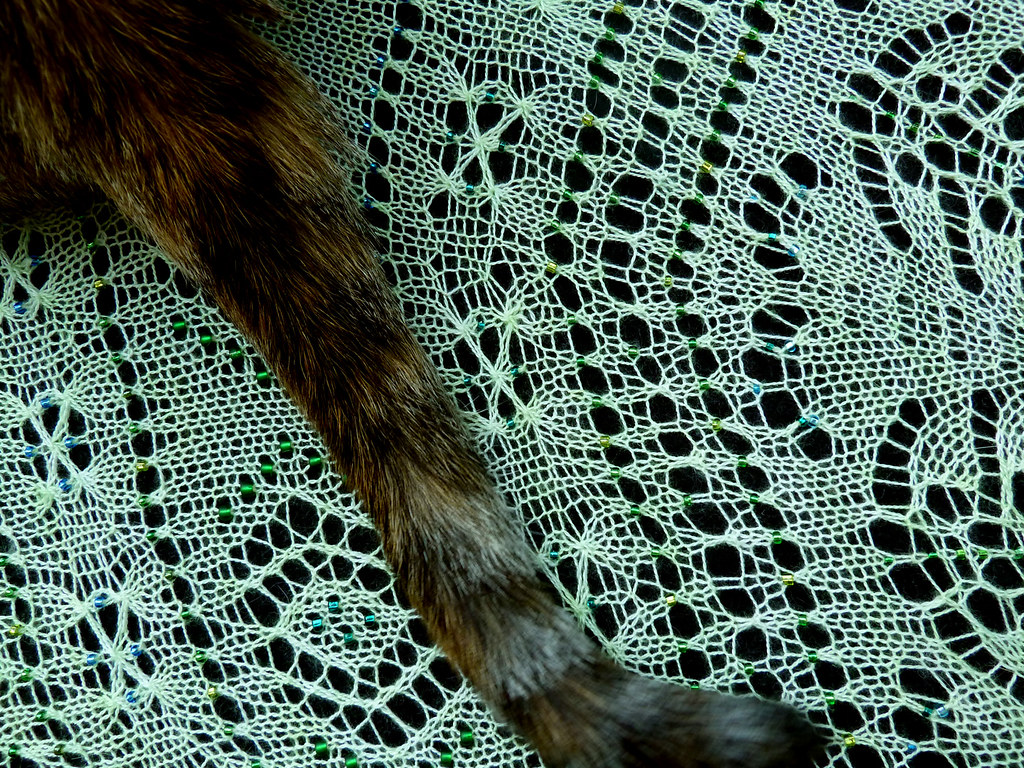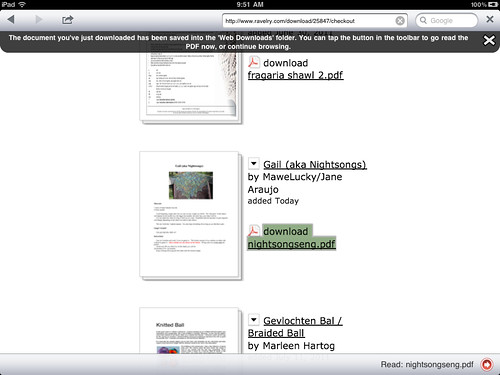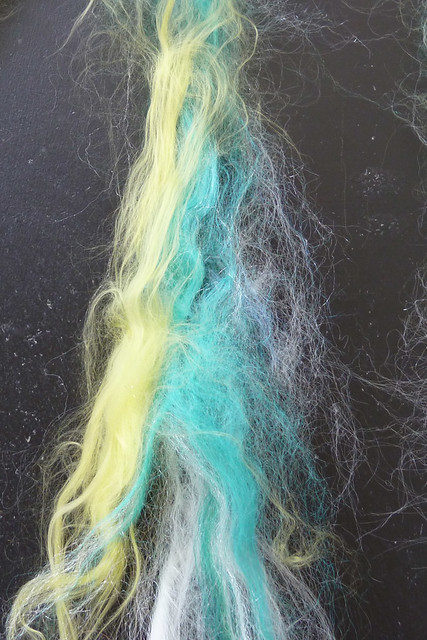Readers of my blog know that I occasionally poke fun, or wickedly sharp needles, at some of the actions taken in the name copyright and trademark. For example, I went to purchase a circular knitting needle a few weeks ago, and noticed that underneath the KnitPicks logo, was the following statement:
The color purple is a trademark of Crafts Americana Group, Inc.
I sent this information off to TechDirt, inquiring how anyone could trademark a color, especially a color as ambiguous as "purple." A lively discussion ensued. A week or so later, someone else pointed out that Cadbury has also trademarked the color purple. Another lively discussion ensued. It doesn't matter whether the companies involved in this silliness were granted trademarks or even applied for them (no and yes), the point is, trademarking colors can be considered a form of restraint of trade, even if it only applies to a candy wrapper, which is apparently how the British Courts ruled for Cadbury.
As far as I know, there are only, what, six main colors, generally known as red, orange, yellow, blue, green, and violet. Let's throw black and white in there and make it eight colors. That means, if candy Company A trademarks red, and Company B trademarks orange, and so on, then Company I has no color they can make their candy wrapper. What do they do? Sell the stuff in a transparent wrapper? Then sure as I am typing here, someone will trademark see-through candy bar wrappers, and then Company J will have to sell their candy naked. Or spend millions of dollars and years in court arguing that Peach isn't Orange.
I could go on and on about the actual color, as KnitPicks needle cables are technically red-violet, not purple. Suppose I want to market knitting needles with lavender cables? Is this purple or pale violet? KnitPicks didn't limit their color trademark to knitting needles either, the way Cadbury did for candy bars. So purple yarn is a trademark violation? Is Barney the Purple Dinosaur going to present a legal hassle for his owner?
And if KnitPicks trademarked the color purple, should Alice Walker, the author of the book, The Color Purple, take legal action? Book titles cannot be copyrighted--there are only so many ways you can say Introduction to Biochemistry, and that's been through the courts. But what if she wants to take out a trademark on, say, purple toothpicks with that slogan engraved on them?
In sum, the entire grabby mentality that pervades business these days is disheartening, not to mention stifling. This is not to say that you shouldn't take appropriate measures to protect your intellectual property, but it seems that companies are spending most of their time and money litigating instead of innovating. And we all know what happens when laws become too stringent--people just ignore them. Or they stage a revolt.
So, when I turned my attention to the front matter of my book, having tired of investigating the spinability of cow hair, I took some volumes off the shelf and looked at their copyright pages. No, no, and more no. I am not going to wander those narrow little roads. Instead, I wrote my own copyright statement, which I hope will provide a broad avenue for everyone who might wish to take a stroll through my book.
Thursday, December 15, 2011
Copyright for the 21st Century
Posted by
fleegle
at
4:04 PM
26
comments
![]()
Labels: Copyright
Sunday, November 27, 2011
Eco-Junk
At the beginning of the year, I promised you guys that I would write a book. After casting about for a subject, I finally decided to write about supported spindling--a topic that is often ignored or relegated to a footnote in most descriptions of hand spinning. It's coming along nicely. So far I have almost 200 text pages and suspect that after adding in all the images, the page count will balloon to 350 or so.
It will be first be published as an ebook PDF with embedded videos, all on a DVD. Those who wish printed copies will have to sign up for a subscription. It's a full-color book, and printing will be very expensive--about $30, plus the cost of the DVDs, shipping, and so on. A subscription with a down-payment will allow me to actually pay for the printing.
Right now, it looks like I will be finished with the text by the end of the year. Then it has to be tech-edited, copy-edited, laid out, proofed, and the videos created. I am aiming for publication somewhere between April and June.
In the meantime, I know that many readers don't spin, but half the book talks about various fibers. And so, here's is the first of several excerpts that I will be putting on this blog. All the images and spinning info have been removed here due to length considerations, but I hope you enjoy this brief tour of.....
Eco-Junk
Bamboo
Soy Fiber
Corn Fiber
Milk Fiber
Crab(Chitosan )
Posted by
fleegle
at
2:07 PM
21
comments
![]()
Tuesday, November 15, 2011
A Long Story
Semele is a terrific design for which I specially spun the yarn. I wanted the ends of the shawl to be dark blue, fading to white in the center, which is why the balls are wound the way they are. The lovely merino batts were made byLeilani Sue, and I bought the batts from her Etsy store, Heavenly Fiber. As you can see from the picture, I added plenty of Angelina for sparkle.
I heartily recommend the pattern, which had not a single error and left nothing to the imagination. It's worth knitting for the clever beginning leaf, from which the rest of the pattern flows without a hitch.
I was so careful after spinning. I measured and weighed the skein twice to be absolutely sure that I had two identical halves. But clearly Harry put his legs on the scale when my back was turned, because when I got to the last three leaves, I ran out of yarn.
I frantically emailed Leilani Sue, who was in the process of moving and thus had everything neatly packed in boxes. I whimpered. I whined. I sniffled. And dear Leilani Sue unpacked some boxes and found what she thought was the right color. Um, it wasn't. So I sent her a little sample of the spun yarn, and she unpacked more boxes and finally found a precious ounce of the dark blue.
So, after a month of squirming in anticipation, the merino arrived and I spun it up. The next day, Semele was finished and I gleefully started pinning it out. And pinning it out. And pinning it out some more...

The length was my fault, because I kept knitting the center repeat until I had used up all the white, at which point the design faded back to blue. As I never bothered to measure it on the hoof, as it were, I got a long surprise when I blocked it.
Well, it will certainly wrap around me a whole lot of times...
Posted by
fleegle
at
5:31 PM
11
comments
![]()
Sunday, October 23, 2011
Yarn Guides
 |
| Pink Sago Palm Bohus from http://www.solsilke.se/ |
Posted by
fleegle
at
11:55 AM
30
comments
![]()
Friday, August 19, 2011
May Queen Mystery Shawl
A sweet knit from Tiziana, the May Queen started out as a mystery shawl from one of my favorite designers. The pattern is quite easy, so I thought I would experiment with my very own Firebird yarn and some colored bead sequences. Unfortunately, the #8 beads were really too small to show off my clever gradients and could hardly even be seen at normal viewing distance. But the beads were an adventure, and rather than writing about the perils of using ten different colors of teeny, tiny, round, bouncy, exuberant objects, I shameless quote kath1996's description (with her kind permission) of her own interaction with the little rascals. The experience closely mirror my own except that she used a single color, so you can multiply this scary scenario tenfold:
Laptop is a little too finicky to eat beads, but that did not deter her from Getting In The Way from the beginning to the end of this shawl. I can't figure out the attraction--Firebird is odorless, the color is not red (which she finds attractive), and it doesn't resemble either a hamster or the ugly brown scarf thing she enjoys cuddling. I couldn't get her off my lap for the entire project, and, as you can see, once the project was completed, she claimed complete possession, beads and all.
Attempts to remove her were met with The Look:
And she followed up The Look with The Snooze:
A few hours later, I filled her food bowl--a guaranteed draw--and snapped a few Laptop-less photos:
Well, almost...
Posted by
fleegle
at
6:30 PM
24
comments
![]()
Tuesday, August 2, 2011
Batt Editing--Part 2
Readers of this blog probably know how much I love glitz, but many battmeisters eschew such additives for a variety of reasons. Anna of Corgi Hill decided against working with Angelina fiber after a bag of it exploded and left her, well, rather sparkly. Others feel that Firestar (trilobal nylon) and Angelina are scratchy. And some feel glittery yarn is somehow undignified.
Not me! I love to spin with glitz, I love to knit with glitz, and search out batts containing glitz, preferably in high concentrations. So it should come as no surprise that I figured out a simple way to add sparkle to batts that lack what I consider an essential ingredient.
If you paid attention to my first Batt Editing post, you might recall that I showed you how to split a batt into two layers. But if not, let me show you again.
Here we have a perfectly lovely example of a glitz-less batt from the immensely talented Zauberzeug
:
I carefully peel the two layers apart...
...and sprinkle the bottom layer with Angelina:
Just flop the top layer back on the bottom layer:
And roll it back up:
Needless to say, you can use this technique to add anything you might want to spin--strands of silk, Firestar, exotic fibers of which you only have a tiny bit,
On another note, I promised you some killer tomatoes, so I would be remiss if I didn't include a photo, taken several weeks ago. At that time, the plants were approaching 11 feet in height, and had outgrown our double stack of tomato cages by a wide margin.
Roy, who was an Eagle Scout and knows how to do things like assemble tripods, crafted several out of our very own bamboo and is seen in the above photo tying one of the plants, fondly named Terminator One, onto the supports. I should add that the plants are now over 14 feet tall, although we are training them down the supports, because we don't have a taller stepladder and would feel idiotic trying to harvest our crop by tossing rocks at the fruit.
Last year we planted four plants, three of which promptly died. The survivor barely attained a meter in height and spent the entire summer generating six puny tomatoes. This year, we figure to harvest about 200 pounds of fruit from the four plants that were really cute when we plopped them into the soil but now consume a cow a day and we'd better be on time with the feeding....
Posted by
fleegle
at
3:01 PM
13
comments
![]()
Monday, July 18, 2011
Knitting with the iPad
I mostly love my iPad, but I wish someone would write the perfect knitting app. The iTunes store has quite a large handful--counters, project managers, books--but none of them is The Killer Knitting App. Recently, a new program appeared that would seem, from reading the PR, to fulfill my KKA requirements. Errrgh. It was expensive and clumsy to use, and a regrettable expenditure. I won't mention the name, lest I generate hate mail or lawsuits, so instead of whining about The-App-That-May-Not Be-Named, I'm going to show you how to use a program called iAnnotate to work with knitting patterns on an iPad.
Basically, iAnnotate lets you download, read, annotate, organize, and send PDF files. I think it's more flexible for PDFs than GoodReader, but it's also twice the price--$10 vs. $5. GoodReader's advantage is its ability to read multiple formats, so it can handle Word and Excel docs, as well as PDFs. GoodReader's tool set isn't as robust as iAnnotate's, though, so I prefer the latter to the former.
First of all, let's go get a PDF. iAnnotate has a built-in web browser that let's you:
- Convert a web page to a PDF and download it--useful for grabbing Knitty patterns
- Get patterns from DropBox
- Navigate to a PDF in your Ravelry library and download it directly
- Download patterns directly from your Ravelry library via WebDav (a protocol that allows collaboration between users and websites for editing and managing documents and files)
I clicked on the download link...
...closed the browser, and opened the file via iAnnotate's File Organizer screen.
iAnnotate supports multiple tabs, and more importantly, let's you duplicate tabs, so let's play with these. Click on the tab and you'll see a little bar underneath that shows buttons for tab management--Close, Navigator, Share, Duplicate, and so on.

This pattern only has four pages and three charts, so I set up four tabs. The first tab is the intro text; the other three pages hold the charts. There were no surprises in the pattern's Stitch Key, so I didn't bother giving it a separate tab.

As you can see, there's a handy thumbnail panel on the left that can be collapsed when not needed. You can use the panel to whip through your document by page, bookmark, annotation, or outline, or use the toolbar buttons to navigate bookmarks and pages.

Given the name of the app. it's no surprise that there are lots of tools for annotation-- pen, highlighter, typewriter, stamps, notes, straight line, underline, strikethrough, photos, voice recording, and date stamp.You can easily customize your tools, for example, create a set of custom highlighters, import your own stamps (such as a signature), set a custom typewriter color and font, and convert an annotation into a stamp. The only thing missing is a rectangle; GoodReader has one and it's useful. Oh well.
One of the nicest features of iAnnotate is the configurable toolbars. the app has a rather overwhelming number of features, so I made a Knitting toolbar (shown at the bottom of the previous picture) that holds commands I use frequently: Note, Line, Stamp, Typewriter, Bookmark, and so on.You can easily drag and drop what you need into your toolbar, which can then be repositioned and resized as you see fit. You can have multiple toolbars on the page, for example, a set of navigation tools at the top and some highlighters on the bottom.
For some odd reason, you can only highlight text, not images. I like to use charts, so I made a highlighter line to pinpoint my place in the chart. I used the Line tool to draw a long line...
.
...then made it thicker and partially transparent.
You can make the annotation into a stamp if you like, but stamps can only be resized and rotated once in the library. Adjusting the highlight is easy--just tap and slide it to move it up and down.
You can also add a text annotation to the highlight drawing. Notice the annotation can stay open and pinned to a specific place on the page.
Similarly, you can highlight text, and add notes, sound recordings, or images as annotations. The latter is particularly useful if you need to refer to a knitted sample or suggested yarn.

Photos may also be emailed right from iAnnotate...

...or you can send the Photo to another program, such as DropBox.

There are several options for hopping around the PDF. I like the temporary Mark--it's a quick bookmark that holds only a single location. It's very useful for flipping back to a specific place, such as a text description, while you are studying a chart in another tab.

You can also set as many permanent bookmarks as you like, and these can be color-coded to indicate various sections of the pattern (or various testers):
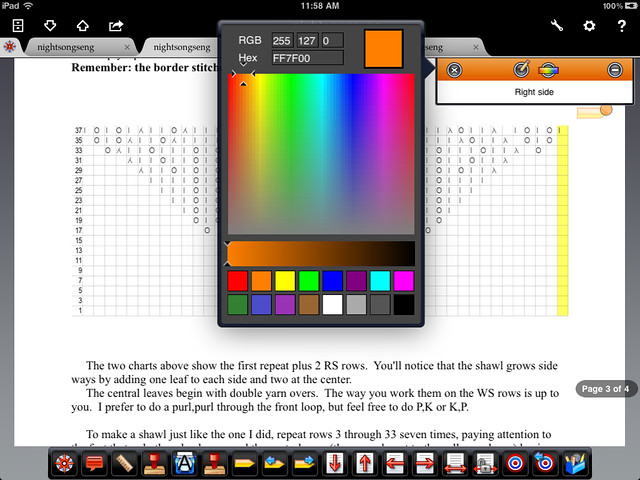
I have Next/Previous Bookmark tools in my toolbar, but if there are a lot of them, open the side panel and tap the desired bookmark.

Your notes, annotations, and drawings may be sent along with the file via email--convenient for test knitters who need to send information back to the designer:

And if you're working on a KAL or test-driving a pattern, you can clip out a problem area of the PDF and send just that section:

As for stitch counters...well, there are a few things you can do to keep track:
- You can double-click click out of iAnnotate and switch to your counter app in the bottom tray...ugly, but workable.
- Use iAnnotate's Typewriter tool to type in numbers and the text editor to mark them in meaningful way.

- Use one of the number stamps.

- Mark repeats on your hand with an indelible marker.
- Line up M&Ms in some predefined increment and eat one at the end of a row.
There are lots of other features in iAnnotate, not the least of which is the ability to rotate pages, add blank pages, and delete pages you don't need.
Printing from iAnnotate, like any other iPad app, depends on your accoutrements and pocketbook. There are any number of printing apps in the iTunes store--they run between $5 and $10. If you have an AirPrint-enabled printer (currently implemented on some HP printers), you can use that feature. Rather than invest money in a separate printing app, I just email the document to myself and print it from my laptop.
iAnnotate has a few silly quirks that I hope will be fixed in an update. You can only highlight text, and all knitting charts are images--the workaround is the Stamp--but it would be nice to be able to directly mark a stitch or row with a finger swipe. You can lock a page horizontally but not vertically. It's awfully easy to inadvertently tap the display and slide to another page. No biggie, but it would be helpful to be able to freeze the page.
Next time: The Attack of The Killer Tomatoes, right here in fleegleland!
Posted by
fleegle
at
3:51 PM
22
comments
![]()
Monday, July 11, 2011
Batt Editing
Although Harry is perfect, the rest of the world generally needs a little tweaking to rival his flawless stature. It's rare that I spin a batt right out of the bag--I usually add or subtract something, especially if I have a specific project in mind.
Harry thought it might be instructional for me to show his faithful readers how I edit a batt. According to him, I don't have any faithful readers, which instigated a shouting match (MORONIC BIPED! HAIRY MIDGET OCTOPUS!, and so on). While we were hurling epithets at each other, Rambo kindly loaded the text and images into the blog and then proceeded to clean out the vegetable bin because nobody was paying any attention, and the lettuce was going to wilt soon, anyway.
Onwards to batts.
Let's take this lovely item from Lampyridae, euphoniously named Sarah Bejeweled. It's an eclectic mixture of milk, bfl, silk, soy, merino, alpaca, and sari silk. but is very smooth, if a bit mussy. Notice the colors after the greens are kinda folded under...you can't see them in this picture.
If you've ever fooled around with batts, you've probably discovered that most of them are layered, and it's easy to separate the layers by gently pulling them apart. The blue and purple are peeking out on the bottom layer in this image:

Here are two two layers, side by side.

Now to strip the batt into bite-sized pieces. I started on the left, coaxing each color transition into a little swathe.

I took a bit of the next color, pink, into the second strip, and a little more pink in the third one--mixing the colors this way makes for smoother transitions.

Sometimes, when pulling off a strip, the wrong color crawls over....
It's easy to just peel it off and put it back where it belongs.
Here's what the deconstructed batt looks like now.
The next step is to do a little drafting. Although the batt is smooth, it has a fair amount of fibery locks lying on the surface. When you try to spin it them in, the loose bits can fall down or become folded over, creating a snarl. If you're spinning thick yarn, this fluffiness isn't a big problem, but for fine spinning, it's better to try and incorporate the little rogues into the main wad of fiber. And because I will be spinning fairly fine on a supported spindle, I want to loosen up the fiber, as well. Both of these tasks are done simply by gently pulling sections of the strip like this:

And here's the first attenuated strip. Notice there's some white fiber that refused to play nicely with the rest of the strip. I just inserted a few twists to keep it from running away.
Here and there, I found some bits of fiber that didn't belong, as well as a few nepps that would simply make a blob while spinning. I just picked them off.
And we're almost finished. Notice the adorable cat toy...Laptop couldn't be with us today, due to a prior engagement, but she left a clownfish proxy for Harry's faithful readers to admire.
The transitions looks pretty good, but the sequence is a bit lacking in blues and purples. Dipping into my batt stash, I found colors that would work, and added a few extra strips.

To keep everything neat and tidy, I rolled up the strips, one after the other, into a squooshy ball...


And put it into a plastic bag. It's ready to go.

On another note, I report that over the course of the last few months, the occupants of the fleegle household endured three eye operations and two root canals, thus triggering our favorite floating holiday: Celebrate Something Random Day. To commemorate such occasions, we always have a cake, decorated especially for the occasion being celebrated. And so I present to you the Infamous Fleegle Eyeball and Teeth Cake of 2011. It was delicious!

And before you ask, Nancy, it's from the Country Bakery on 75 between Ingles and White County Jail. :)
Posted by
fleegle
at
7:22 PM
31
comments
![]()







